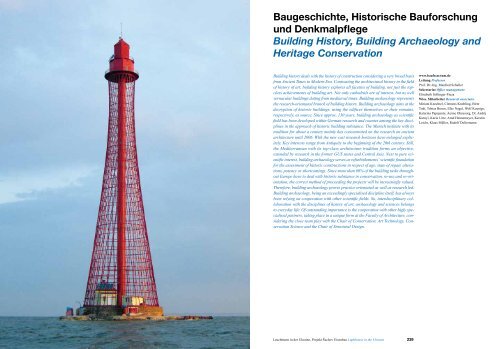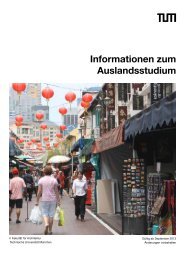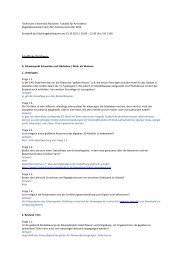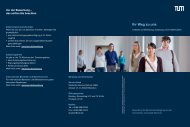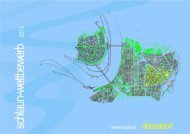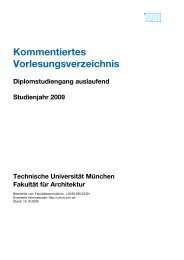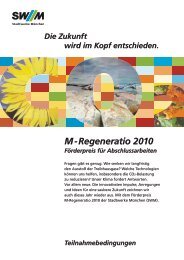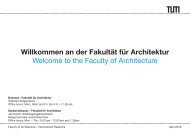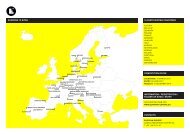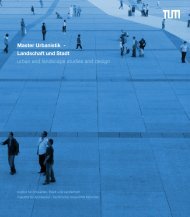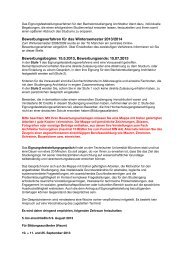Institute Institutes - Fakultät für Architektur - TUM
Institute Institutes - Fakultät für Architektur - TUM
Institute Institutes - Fakultät für Architektur - TUM
Erfolgreiche ePaper selbst erstellen
Machen Sie aus Ihren PDF Publikationen ein blätterbares Flipbook mit unserer einzigartigen Google optimierten e-Paper Software.
Baugeschichte, Historische Bauforschung<br />
und Denkmalpflege<br />
Building History, Building Archaeology and<br />
Heritage Conservation<br />
Building history deals with the history of construction considering a very broad basis<br />
from Ancient Times to Modern Era. Contrasting the architectural history in the field<br />
of history of art, building history explores all facettes of building, not just the topclass<br />
achievements of building art. Not only cathedrals are of interest, but as well<br />
vernacular buildings dating from mediaeval times. Building archaeology represents<br />
the research-orientated branch of building history. Building archaeology aims at the<br />
decryption of historic buildings, using the edifices themselves or their remains,<br />
respectively, as source. Since approx. 130 years, building archaeology as scientific<br />
field has been developed within German research and countes among the key disciplines<br />
in the approach of historic building substance. The Munich institute with its<br />
tradition for about a century mainly has concentrated on the research on ancient<br />
architecture until 2006. With the new cast research horizons have enlarged explicitely.<br />
Key interests range from Antiquity to the beginning of the 20th century. Still,<br />
the Mediterranean with its top-class architecture tradition forms an objective,<br />
extended by research in the former GUS states and Central Asia. Next to pure scientific<br />
interest, building archaeology serves as refurbishements´ scientific foundation<br />
for the assessment of historic constructions in respect of age, state of repair, alterations,<br />
potency or shortcomings. Since more than 60% of the building tasks throughout<br />
Europe have to deal with historic substance in conservation, re-use and re-orientation,<br />
the correct method of proceeding the projects will be increasingly valued.<br />
Therefore, building archaeology proves practice orientated as well as research led.<br />
Building archaeology, being an exceedingly specialised discipline itself, has always<br />
been relying on cooperation with other scientific fields. So, interdisciplinary collaboration<br />
with the disciplines of history of art, archaeology and sciences belongs<br />
to everyday life. Of outstanding importance is the cooperation with other higly specialised<br />
partners, taking place in a unique form at the Faculty of Architecture, considering<br />
the close team play with the Chair of Conservation, Art Technology, Conservation<br />
Science and the Chair of Structural Design.<br />
238 Leuchtturm in der Ukraine, Projekt Šuchov Eisenbau Lighthouse in the Ukraine<br />
239<br />
www.baufo.ar.tum.de<br />
Leitung Professor<br />
Prof. Dr.-Ing. Manfred Schuller<br />
Sekretariat Office management<br />
Elisabeth Sollinger-Fiuza<br />
Wiss. Mitarbeiter Research associates<br />
Miriam Knechtel, Clemens Knobling, Birte<br />
Todt, Tobias Busen, Elke Nagel, Wolf Koenigs,<br />
Katarina Papajanni, Aenne Ohnesorg, Dr. Andrij<br />
Kutnyi, Karin Uetz, Arnd Hennemeyer, Kerstin<br />
Leicht, Klaus Müller, Rudolf Dellermann


